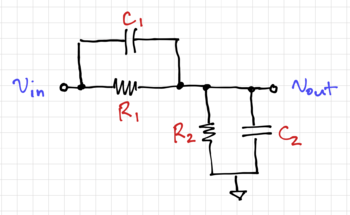- Activity: Simulating simple RLC circuits
- At the end of this activity, the student should be able to:
- Run DC, AC, and transient simulations using ngspice.
A Wideband RC Voltage Divider
One way to build high-speed circuits with relatively large input impedances and capacitances is to use a simple RC voltage divider, as shown in the figure below. This RC divider is commonly found in oscilloscope 10X probes.

Figure 1: A wideband voltage divider circuit.
Let  and similarly
and similarly  . Thus, the output voltage can be expressed as:
. Thus, the output voltage can be expressed as:
-
 |
|
(1)
|
Notice that we can cancel out the pole with the zero when we set  , or equivalently,
, or equivalently,
-
 |
|
(2)
|
Intuitively, we can think if this as a resistive voltage divider at low frequencies, and a capacitive divider with the same ratio at high frequencies. Thus, the output voltage will simply be equal to:
-
 |
|
(3)
|
We can then build a simple 10X oscilloscope probe circuit with an input impedance of  and an input capacitance of
and an input capacitance of  using
using  ,
,  ,
,  , and
, and  . Since the pole and zero cancel each other out, the bandwidth of the probe circuit is not limited by its RC values.
. Since the pole and zero cancel each other out, the bandwidth of the probe circuit is not limited by its RC values.
A Lossy LC Tank
A Simple Switched-Capacitor Circuit












